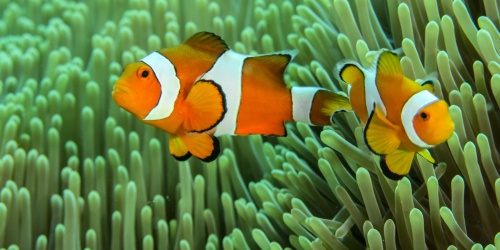
Clownfish swimming among anemone - Photo papzi / Adobe
What is a sea anemone? Anemones are beautiful marine animals with wavy tentacles, and resemble underwater flowers. They are usually brightly coloured, adopting shades of white, green, blue, orange, red or mauve, often contributing to the spectacular walls of invertebrates populating reefs. Species such as the bulb-tentacled sea anemone (Entacmaea quadricolor) and magnificent sea anemone (Heteractis magnifica) form homes for beautiful anemonefish or clownfish, which shelter from predators in the anemone’s stinging cells. Certain species of sea anemones are thought to be able to survive for 100 years or more.
Where do sea anemones live? Anemones usually attach themselves to rocks and underwater structures, although some species burrow into mud or sand.
What do they look like? One of the most common anemones around the metropolitan area is the cherry anemone (Actinia tenebrosa), a brilliant red animal that withdraws its tentacles when the tide is out, resembling a cherry. Some species in tropical areas, such as the magnificent sea anemone, can grow very large.
What they eat and how: Sea anemones are carnivores that take an unusual guise. Their beautiful flower-like tentacles have a sinister purpose. Fish, snails or crabs that blunder into these waving fronds are soon paralysed by the stinging tentacles, engulfed by the central mouth and digested within the tube-like body.
Behaviour: These animals fix themselves to reefs and other structures by the muscular disc at the base of the body. Though they usually move very little, they can creep along the bottom or may detach themselves and swim off. Anemones are closely related to jellyfish. The body is a tube-like column, which is divided internally into a number of partitions containing the digestive organs, muscles and gonads. Waste is excreted through the mouth at the top of the body in the centre of the long tentacles.
Breeding: Anemones produce fully developed young through the mouth, which usually attach themselves to a rock near the parent. As a result they are often seen in groups.



























